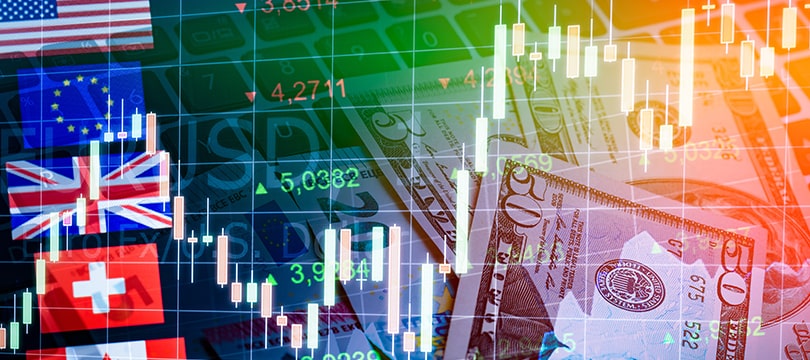The world of modern trading is characterized by a complex network of interconnected financial markets.
Forex,
stock indices,
commodities, and
cryptocurrencies are financial instruments that, while operating in distinct markets, are strongly interconnected through correlation dynamics. Understanding these correlations is crucial for traders who wish to diversify their portfolio, manage risk effectively, and identify profitable trading opportunities. In this article, we will explore the main correlations between these markets and how they can influence trading decisions.
1. Correlations in the Forex Market
Correlations between Currencies
Currencies in the
Forex market are often correlated with each other. There are two main types of correlation:
- Positive Correlation: When two currencies move in the same direction. For example, EUR/USD and GBP/USD tend to move together. When the US dollar weakens, both pairs tend to rise.
- Negative Correlation: When two currencies move in opposite directions. A classic example is EUR/USD and USD/CHF. When the US dollar strengthens against the euro, it also tends to strengthen against the Swiss franc, leading to opposite movements in the two currency pairs.
Practical Example:
Suppose a trader has a long position on
EUR/USD. If they notice a strong positive correlation with
GBP/USD, they might decide to open a long position on
GBP/USD as well, anticipating a similar movement. However, if the trader has a long position on
EUR/USD and a short position on
GBP/USD, they might be exposed to correlation risk that could cancel out gains. Conversely, by understanding negative correlation, a trader could hedge their positions to mitigate risks.
2. Correlations between Forex and Stock Indices
The Influence of Stock Indices on Forex
Global stock indices, such as the
S&P 500,
Dow Jones,
NASDAQ, and
FTSE 100, are often correlated with certain currency pairs. In particular:
- US Dollar and US Stock Indices: An inverse correlation is often observed between the US dollar and US stock indices. When indices rise, investors tend to sell US dollars to buy riskier assets, weakening the dollar.
- Emerging Market Currencies: Stock indices in emerging markets, such as the MSCI Emerging Markets Index, tend to be positively correlated with the currencies of these markets (e.g., BRL, ZAR, TRY). An increase in these market indices can lead to a strengthening of their currencies.
Practical Example:
A trader observes that the
S&P 500 is experiencing a significant rally. Historically, this could indicate a weakening of the US dollar. The trader might then decide to short
USD/JPY, anticipating a decline in the dollar against the Japanese yen. Similarly, a fall in stock indices could lead to a strengthening of the dollar, suggesting buying opportunities in pairs like
USD/CHF.
3. Correlations between Forex and Commodities
US Dollar and Commodities
Commodities, such as gold, oil, and copper, are often priced in US dollars, creating an intrinsic relationship between the value of the dollar and commodity prices.
- Gold and US Dollar: Historically, gold has an inverse correlation with the US dollar. When the dollar weakens, gold tends to rise, as it becomes cheaper for buyers using other currencies.
- Oil and Currencies of Oil-Exporting Countries: The price of oil is strongly correlated with the currencies of oil-exporting countries such as the Canadian dollar (CAD) and the Russian ruble (RUB). An increase in oil prices tends to strengthen these currencies.
Practical Example:
If a trader anticipates an increase in oil prices, they might decide to go long on
CAD/JPY, expecting a strengthening of the Canadian dollar against the Japanese yen. At the same time, they could short
USD/CAD, anticipating a weakening of the US dollar against a stronger Canadian dollar. Another strategy could be to invest in pairs like
AUD/USD, given that Australia is a major exporter of commodities.
4. Correlations between Forex and Cryptocurrencies
Bitcoin and the US Dollar
Bitcoin (BTC) is often considered a sort of "digital gold" and has shown an inverse correlation with the US dollar, similar to that of physical gold. When the dollar weakens, investors might seek refuge in Bitcoin, pushing its price upward.
- Cryptocurrencies and Fiat Currencies: Cryptocurrencies can have both positive and negative correlations with fiat currencies. For example, during periods of economic uncertainty, Bitcoin might increase in value while traditional currencies like the USD weaken.
Practical Example:
A trader notices that the US dollar is going through a period of weakness due to rising inflation. Anticipating that investors will seek alternative assets like Bitcoin, they might decide to buy
BTC/USD, hoping to profit from the rising price of Bitcoin against a weaker US dollar. Conversely, a strengthening dollar could lead to a decrease in the value of cryptocurrencies, offering selling opportunities.
5. How to Use Correlations in Trading
Correlation-Based Trading Strategies
Understanding
correlations can help traders diversify risks and build more robust portfolios. For example, a trader might use the correlation between gold and the US dollar to hedge against risks associated with a dollar investment by purchasing gold as a hedge.
- Correlation Arbitrage: Some traders use temporary discrepancies in correlations to profit. For example, if two highly correlated assets temporarily move in opposite directions, the trader might exploit this divergence with arbitrage trades.
- Portfolio Diversification: Negative correlations can be used to build diversified portfolios that better withstand market volatility. For example, a trader might balance a long position on EUR/USD with a short position on USD/CHF to reduce risk.
Moreover, analyzing correlations can help traders avoid overexposure to certain risks. For example, if a trader has multiple positions on strongly correlated assets, they might be exposed to greater risk than anticipated.
Conclusion
The
correlations between
Forex,
indices,
commodities, and
cryptocurrencies offer traders unique opportunities to diversify, manage risk, and optimize their trading strategies. However, it is important to remember that correlations can change over time, depending on global economic conditions, monetary policies, and other macroeconomic factors. For this reason, traders must closely monitor these relationships and adapt their strategies accordingly.
Knowing and understanding the
correlations between these markets is a crucial element for successfully navigating the complex landscape of modern trading.




